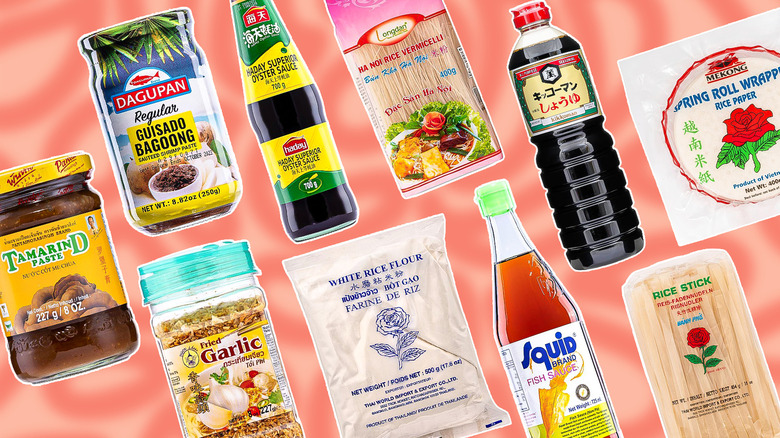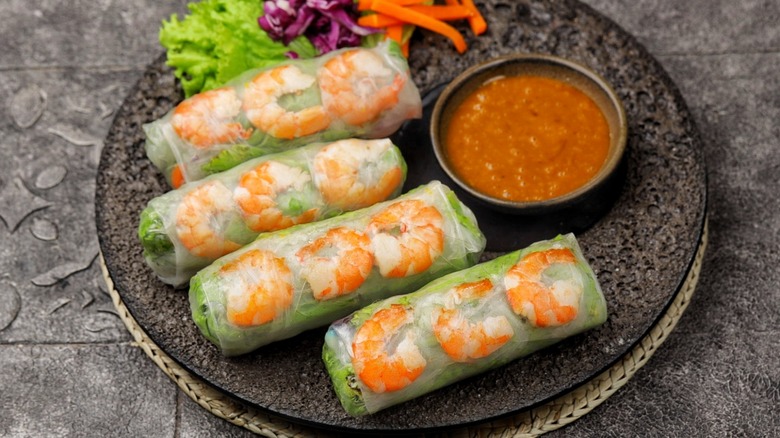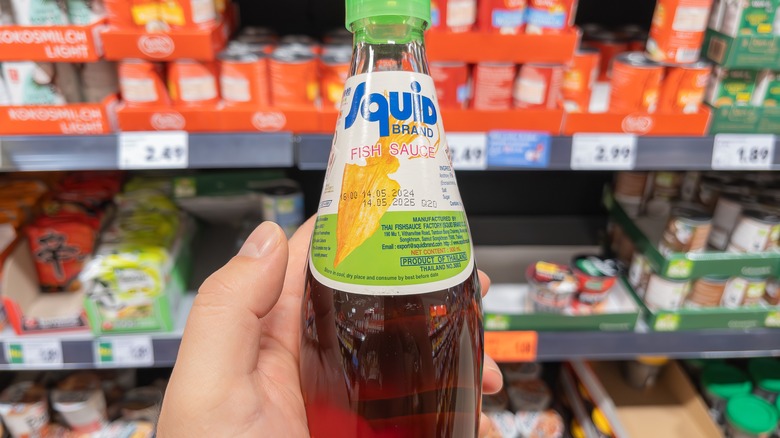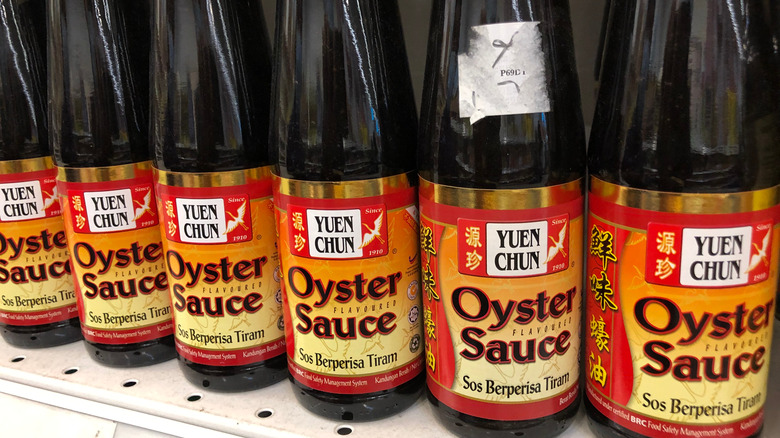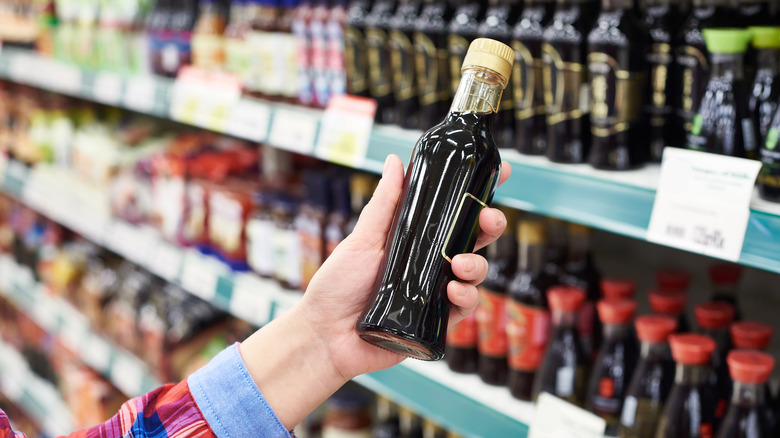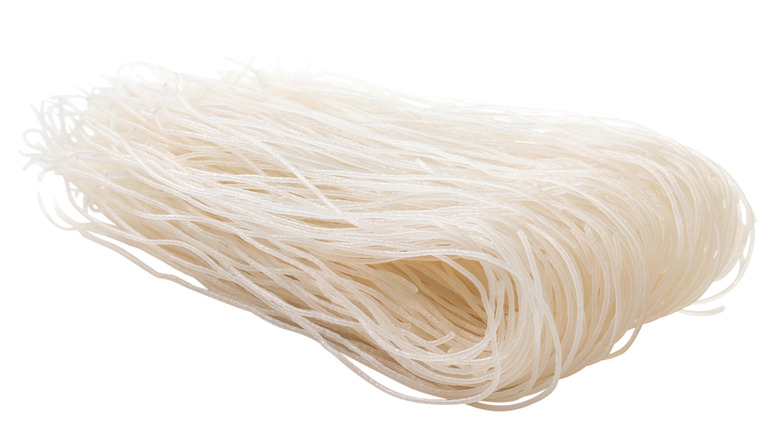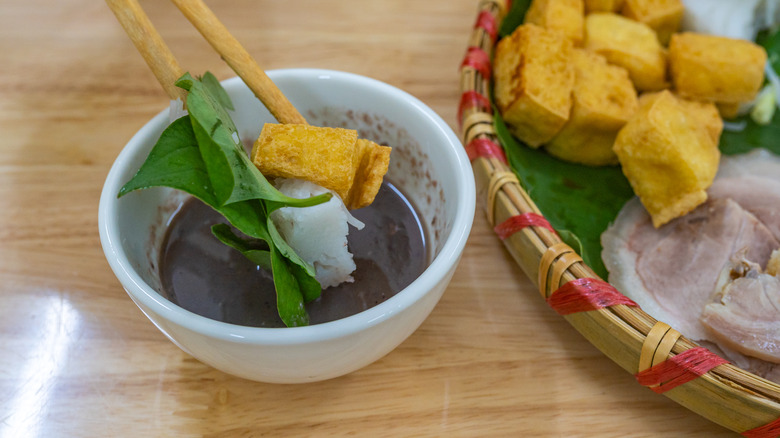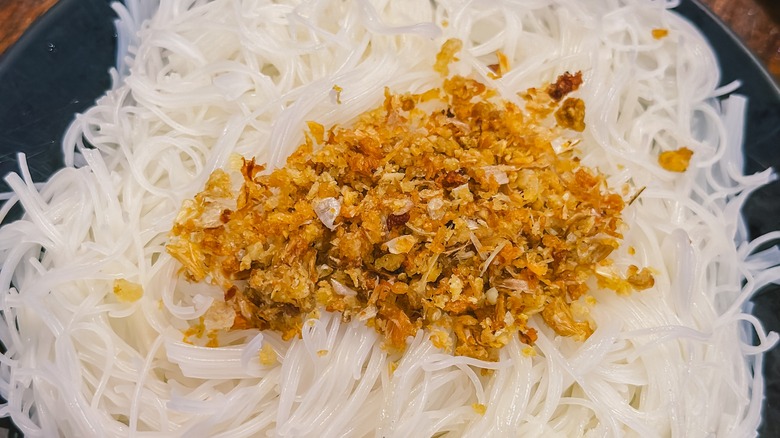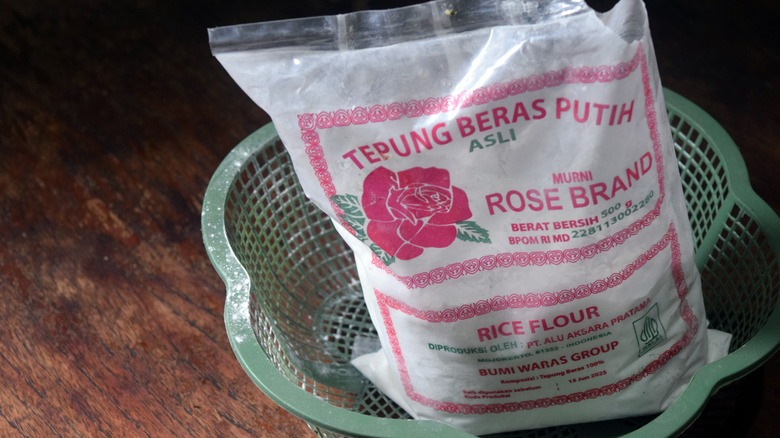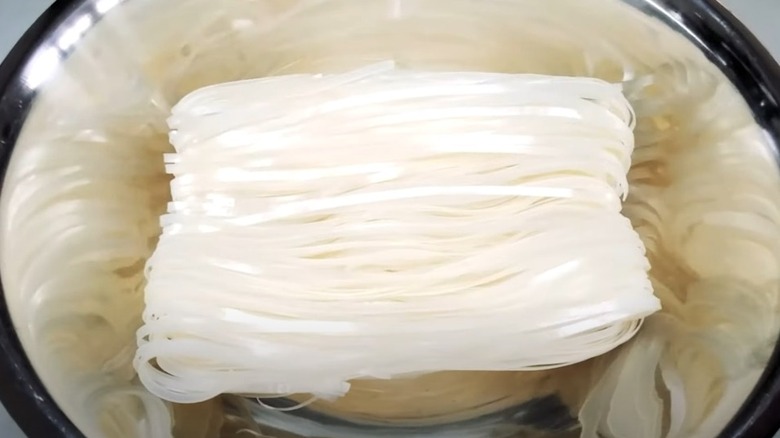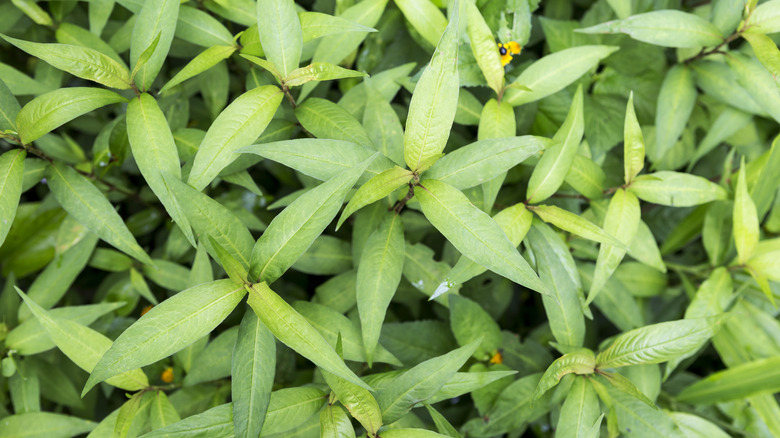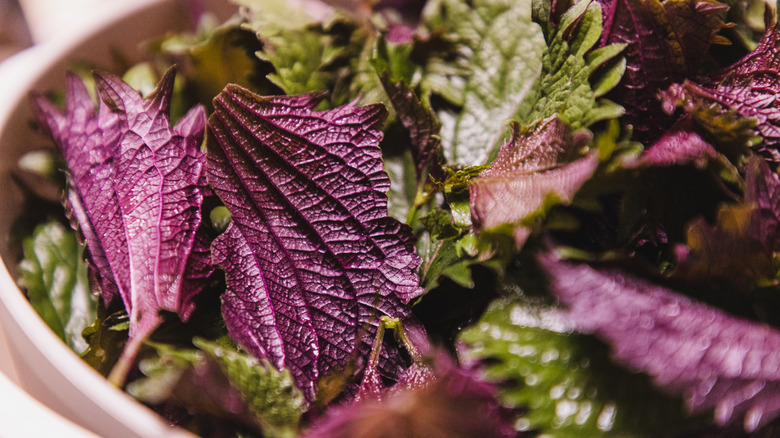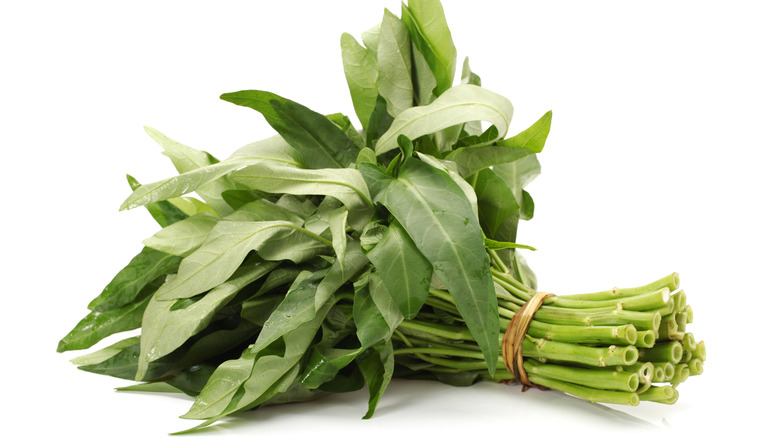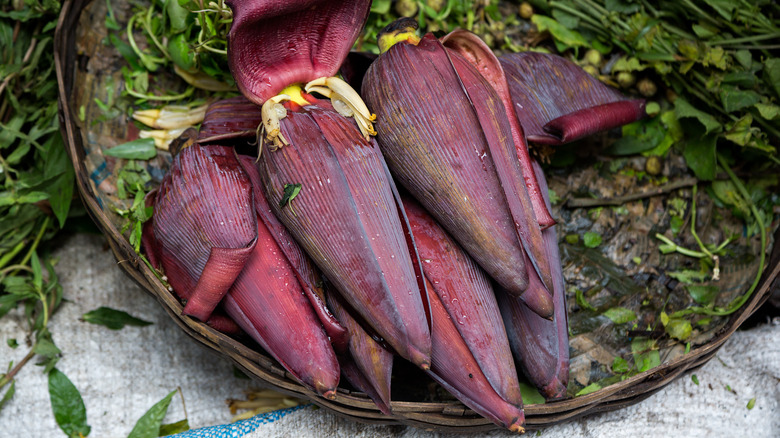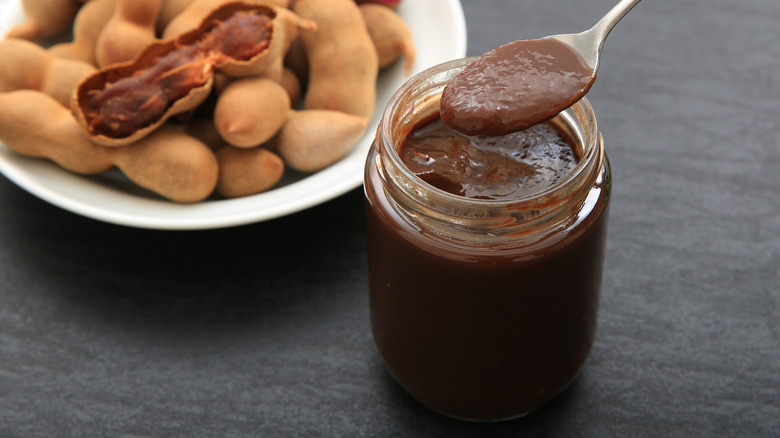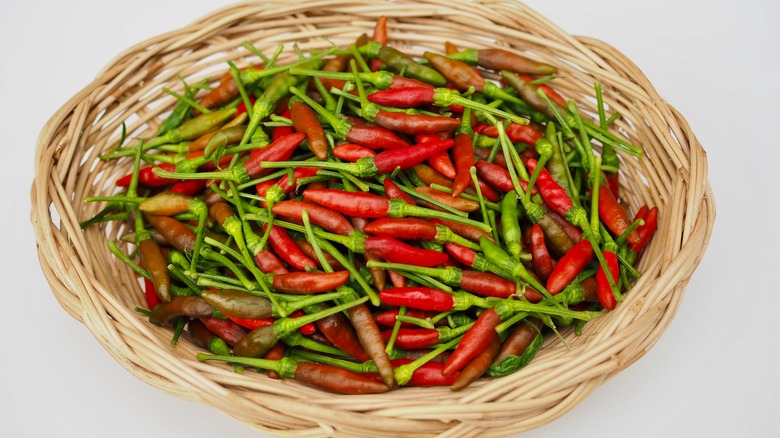15 Best Ingredients To Buy At A Vietnamese Grocery Store
Vietnamese cuisine has long been savored by foodies across the world, with its bold, aromatic, and diverse flavors. But you don't necessarily need to visit a restaurant to enjoy an array of mouthwatering Vietnamese dishes. It's actually far easier than you might think to recreate authentic recipes in your home kitchen.
Pay a visit to your local Vietnamese grocery store, and you'll find everything you need to whip up your favorite dish. From vibrant herbs to unique sauces, the shelves are stocked with staples that form the backbone of this beloved Southeast Asian cuisine. While you will also find some items in mainstream supermarkets, the authenticity, quality, and variety available at a dedicated Vietnamese grocery store are unmatched. Best of all, many of these ingredients are more affordable than those in standard grocery stores and often sold in larger quantities.
With shelves stocked high with intriguing ingredients, we understand that browsing can sometimes be a little overwhelming. That's why we've rounded up 15 essential ingredients that are absolutely worth picking up on your next visit to the Vietnamese grocery store. Whether you're looking to recreate a fragrant bowl of pho, whip up some refreshing summer rolls, or simply explore new flavors, this selection of goodies is guaranteed to help you bring authentic Vietnamese flavors into your home.
1. Rice paper wrappers
To kick things off, we have a pantry staple that no Vietnamese kitchen should be without. Rice paper wrappers are versatile ingredients that come in the form of dried, flat disks made from rice flour, water, salt, and sometimes tapioca starch. You'll typically see them used to make summer rolls, crispy fried rolls, or dumplings.
To use rice paper wrappers, simply dip them briefly in water to soften. You'll find that they take on a slightly chewy texture. If you're making classic Vietnamese summer rolls, simply fill the wrappers with your choice of protein, fresh herbs, vermicelli noodles, and crunchy vegetables. Popular fillings include pork, shrimp, lettuce, mint, and chives. Once filled, roll the wrappers tightly, and you've got a perfect appetizer or light meal. You could also mix up a delicious dipping sauce for your rolls, such as a sweet chili or peanut-hoisin sauce.
These wrappers are a fun way to make customizable, hands-on meals, letting each person choose their own fillings. Plus, they're a fantastic gluten-free alternative to wraps and sandwiches.
2. Fish sauce
What can only be described as a cornerstone of Vietnamese cuisine, fish sauce is essential for adding flavor to a whole host of much-loved dishes. This savory, umami-rich condiment is made from anchovies, salt, and sugar. As expected, it has a deep, salty, fishy flavor but also a touch of sweetness that does a fantastic job of enhancing the taste of other ingredients. Fish sauce features in countless Vietnamese recipes, including the famous dipping sauce nuoc mam, often served as an accompaniment to summer rolls, used as a meat marinade, or added to soups.
Vietnamese fish sauce is often less intense than its Thai counterpart, offering a more subtle flavor that won't overpower dishes. Look for brands that are clear, light amber in color, and have minimal ingredients. High-quality fish sauce shouldn't contain a long list of artificial additives. Don't be surprised to find a wide range of options in Vietnamese grocery stores, from standard to premium varieties and even vegetarian alternatives. So, experiment with different brands to find the one that suits your taste buds.
3. Oyster sauce
Oyster sauce is another essential condiment that's great for adding depth and that perfect balance of salty sweetness to many Vietnamese dishes. This flavorful ingredient has a deep reddish-brown hue and a thicker texture than fish sauce. It's typically made from oyster extract, sugar, salt, water, and thickeners. Oyster sauce pairs beautifully with vegetables, seafood, and meats, giving them a rich, caramel-like taste.
Oyster sauce originated in Southern China in the late 1800s when chef Lee Kum Sheung accidentally left a pot of oyster soup boiling for much longer than intended. The resulting thick, gravy-like sauce was surprisingly delicious! Though still very much associated with Chinese cuisine today, this sauce certainly plays a significant role in Vietnamese cooking, too. You'll often see it used to season greens like morning glory, coat noodles, and enhance the flavor of braised meats. When buying oyster sauce at a Vietnamese grocery store, look for brands that use natural oyster extract rather than artificial flavorings, as they offer a more authentic taste. According to Asian food company Lee Kum Kee, a good quality oyster sauce will "uplift the taste of all the ingredients."
4. Soy sauce
While you might already be a frequent user of this umami-rich condiment, it's certainly worth taking a look at the bottles on offer at your local Vietnamese grocery store. You'll likely find a wider range of soy sauce brands, ranging from light to dark, with unique flavor profiles to suit different dishes. Bigger bottles are often available and cheaper than you'd find in standard grocery stores, so buying in bulk can be a cost-effective option if soy sauce is a staple in your kitchen.
Soy sauce comes in many forms. While light, Chinese-style soy sauce is the most common variety you will find on Vietnamese supermarket shelves, you will also find a variety of premium soy sauces that tend to offer a richer flavor profile. As well as these, there's dark soy sauce, which is slightly thicker and sweeter, gluten-free soy sauce made without wheat, and low-sodium soy sauce. Some brands also offer soy sauce enhanced with mushrooms or other flavors. In Vietnamese cuisine, soy sauce is frequently used as a dipping sauce, an ingredient in meat marinades, or a seasoning for noodles.
5. Rice vermicelli noodles
Rice vermicelli noodles are in everything from fresh salads to hearty soups in Vietnamese dishes. These noodles are easy to prepare, requiring a simple soak in warm water for roughly 15 minutes until they're soft and tender, and are typically gluten-free. You can use them in dishes like bun rieu (pork and crab noodles soup), summer rolls, or as a base for noodle bowls with an array of toppings. They'll also fit perfectly into a range of other Asian-inspired recipes, too, like Singapore noodles or coconut curry, serving as the perfect base to absorb the aromatic flavors of sauces, dressings, and broths.
Vermicelli noodles are typically sold dried in large bundles, and Vietnamese grocery stores tend to stock a variety of brands with different widths and textures to choose from. Rice vermicelli has a starchy texture and opaque appearance post-cooking, great for soups and noodle bowls. When shopping for these, look for noodles made with just rice flour and water for the most authentic texture. They are not the same as bean thread vermicelli or glass noodles, which are made with mung bean flour. These tend to be finer and more translucent, with a somewhat slippery texture. Glass noodles are often used in stir-fries or to fill spring rolls.
6. Fermented shrimp paste
As you might be able to gauge from the name, fermented shrimp paste is a rather pungent condiment frequently used in Vietnamese cooking for its strong, savory kick. It's made by leaving salted shrimp to ferment and has a thick, paste-like consistency. While the smell might be intense, the flavor it delivers is a powerful tool for elevating a range of dishes, much like how anchovies are often used to build savory depth in Western cooking.
A little goes a long way with this flavorful ingredient, so start with a small amount when adding it to your recipes. It's an essential component in the dish thit kho mam ruoc, which features pork belly cooked in an aromatic sauce. It's also used in bun dau mam tom to create the mam tom sauce by mixing it with lemon juice, sugar, and garlic. This is then paired with rice noodles, diced tofu, and green veggies. But you can use fermented shrimp paste just about anywhere you'd like to add the ultimate dose of umami richness, such as in stir-fries, curries, soups, and dipping sauces.
7. Fried garlic
This simple yet potent ingredient is a game-changer for adding crunch and an enticing aroma to Vietnamese dishes. Fried garlic consists of tiny, perfectly crispy morsels of garlic that have been fried in oil until golden brown. Since it's shelf-stable, you can store this ingredient alongside your herbs and spices, reaching for it whenever your recipe is in need of a quick aromatic hit. It makes for an incredibly convenient addition to your pantry with no peeling, chopping, or mincing required.
One recipe that commonly uses fried garlic is Vietnamese peanut sauce. To make this, the fried garlic is heated with peanut butter, Sriracha, water, sugar, and salt before blending everything into a smooth sauce. Peanut sauce with fried garlic serves as a great dip for summer rolls. Fried garlic also makes a fantastic topping for soups, noodle dishes, and salads. Just sprinkle a handful over dishes to elevate them instantly with a pop of garlicky goodness.
8. Rice flour
Rice flour is another valuable Vietnamese staple, playing a crucial role in a variety of recipes. Made from finely milled rice, it has a smooth texture and is naturally gluten-free. Rice flour is a key component in making Vietnamese crepes (banh xeo), steamed rice cakes (banh beo), and various kinds of dumplings and noodles.
To make banh xeo, rice flour is typically combined with another type of flour, such as cornstarch or all-purpose flour, as well as turmeric, coconut milk or cream, water, and green onions. The batter is then poured into a frying pan over pieces of cooked onion, pork, and shrimp and swirled around the pan to create a savory crepe. After topping with mung beans and bean sprouts and covering the pan until everything is cooked through, the crepe should easily fold in half and slide off onto your plate, ready to enjoy.
As well as standard rice flour, you might also come across glutinous rice flour at Vietnamese grocery stores made from sticky rice. Yielding a chewier texture when cooked, this type of flour is perfect for creating desserts like the sweet, filled glutinous rice balls known as banh troi.
9. Rice noodle sticks
When making pho, the iconic Vietnamese soup, rice sticks (sometimes called banh pho) are the noodles of choice. Like rice vermicelli noodles, rice sticks are made with rice flour and water, though they tend to be flatter and thicker, with a slightly chewy texture that's perfect for soups and stir-fries. Available both dried and fresh, rice sticks come in various widths, from thin to thick, so you can choose the best fit for your favorite type of pho.
Cooking rice noodle sticks is a simple process. Depending on the variety you go for, they might need just a quick blanch or require boiling on the stovetop for a few minutes. If you're buying them fresh, they can often be tossed straight into the dish as they are. Fresh noodles tend to have a slightly more robust, moist texture, but dried noodles are, of course, incredibly convenient with their longer shelf life. To assemble a bowl of pho, first layer the prepared noodles in the bottom of the bowl before adding the meat and ladling the steaming broth on top.
10. Rau ram (Vietnamese cilantro)
If you love warm, fragrant flavors, rau ram is a must-try for your next Vietnamese feast. This green herb is also referred to as Vietnamese cilantro, though it packs a stronger taste than its common counterpart. You'll find that its peppery and citrusy notes complement the boldness of other typical Vietnamese ingredients.
Rau ram is a staple in the dish bun bo hue, a spicy beef and pork noodle soup, where it's typically scattered on top alongside other fresh and vibrant ingredients like beansprouts, lime, and red cabbage. Rau ram can also be added to fresh salads, spring rolls, and curries for extra herbaceous flavor. It pairs particularly well with other aromatics like ginger, lemongrass, and chili peppers.
While you can absolutely grab a bunch at your local Vietnamese grocery store, you can also grow your own rau ram at home. Plant it in a container, pop it in a warm, sunny spot, and water frequently, and you'll soon have an ample supply of rau ram for whenever your home cooking needs a fragrant flavor injection.
11. Perilla
Another well-used herb amongst Vietnamese cooks is perilla, a unique herb with a strong earthy flavor reminiscent of licorice, making it an acquired taste for some. The leaves are broad and green with a reddish-purple underside, so they're great for adding a pop of color to your dishes.
Perilla is generally eaten raw, used as a garnish for noodle dishes and grilled meats, or incorporated into Vietnamese salads and spring rolls. You could even whip up a refreshing perilla cocktail. Just muddle the leaves with mint and lime juice before adding simple syrup, rum, lemongrass cordial, and tonic water.
This herb is also frequently used in Korean cuisine. One popular dish is stuffed perilla leaves (kkaennip jeon), where each leaf is filled with a seasoned ground beef mixture before being folded, coated in egg and flour, and pan-fried. Perilla leaves can also be pickled in a mixture of broth, vinegar, soy sauce, and sake, requiring just a few days in the fridge before they can be enjoyed as a tangy and flavorful side dish.
12. Rau muong (morning glory)
Rau muong, also known as morning glory or water spinach, is a leafy green vegetable with a crisp texture and a mild flavor. It's super versatile and easy to prepare, often tossed into a simple stir-fry with garlic and seasoning. Those tender leaves are perfect for soaking up the flavors of other ingredients. Rau muong is also incredibly nutritious, rich in vitamins C and A, as well as minerals like iron, potassium, and magnesium.
To make a classic Vietnamese stir-fried morning glory dish, first prep your greens. You'll need to trim away any woody ends and chop the bunch into bite-sized chunks before soaking the pieces in a bowl of water for an hour. Once soaked and thoroughly cleaned, boil the rau muong for a couple of minutes to tenderize it. Next, saute some minced garlic in a little oil and add the drained rau muong. Finally, pour in a mixture of oyster sauce, sugar, and water, tossing everything together over high heat for a final couple of minutes.
13. Banana flower
Perhaps one of the most exotic ingredients in our lineup is banana flowers — the large, reddish-purple blossoms that grow on banana trees. When picking up a banana flower at the Vietnamese grocery store, it will usually come whole, requiring some preparation before it can be added to your recipes. Its outer layers can be peeled back and removed, revealing tender inner petals that must then be washed and soaked. Banana flower petals have a unique taste, offering subtly nutty and floral notes. Their flavor is often compared to that of artichoke leaves or bamboo shoots.
Banana flower salad is a classic Vietnamese recipe where the petals are thinly sliced and combined with sauteed shallots, peanuts, and herbs before being tossed in a tangy lime and peanut dressing. To ensure the tough outer leaves of the banana flower don't go to waste, try using them as serving boats for the salad or even for other rice dishes and curries.
14. Tamarind
While it might be best known for being a star ingredient in a classic pad Thai, tamarind also has its place in Vietnamese cuisine. Typically coming in the form of a thick paste or block, tamarind is valued for its rich, tangy flavor, used to add acidity and depth to soups, sauces, and marinades. This dark, sticky ingredient is actually a fruit found inside bean-shaped pods that grow on the tamarind tree.
If you buy a solid block of tamarind, you may need to break a piece off and combine this with hot water before using it in your recipe. The paste, however, is more convenient and requires no preparation. In Vietnamese cooking, tamarind is a key ingredient in many dipping sauces for spring rolls and other fried snacks. It's often added to stir-fries with pork or chicken and also features in the dish canh chua — a sweet and sour soup made with fish and vegetables.
15. Bird's eye chilies
Small in size but big on heat, bird's eye chilies are little red or green peppers that certainly pack a punch. Though they can also be purchased dried and ground, fresh chilies are the most frequently used form of this fiery ingredient in Vietnamese dishes.
Bird's eye chilies are also known as Thai chilies, but they actually originate in Mexico. Favored for their punchy spice level, they're used to liven up all kinds of Asian-inspired dishes, from curries and soups to salads and sauces. Nem chua, a Vietnamese cured pork dish, bird's eye chilies are minced and incorporated into the ground pork mixture along with aromatic garlic and peppercorns. These pint-sized chilies can also be finely chopped and added to the traditional nuoc cham sauce, along with fish sauce, sugar, vinegar, and lime juice.
If you're new to bird's eye chilies, start with a small amount and gradually increase the quantity to suit your spice tolerance. They're a fantastic way to add heat to your cooking without overpowering the other flavors.
